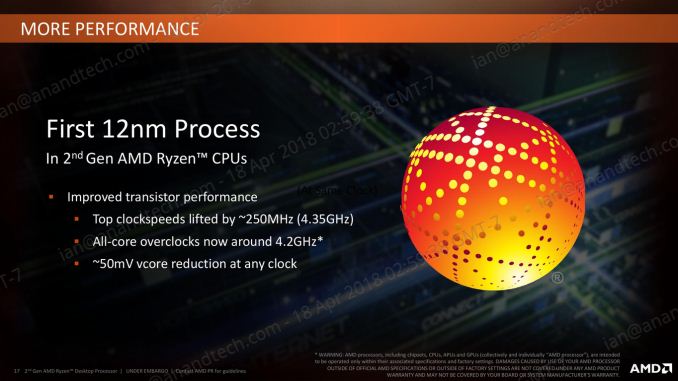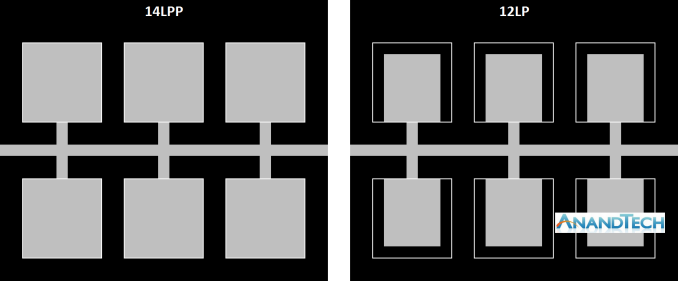The AMD 2nd Gen Ryzen Deep Dive: The 2700X, 2700, 2600X, and 2600 Tested
by Ian Cutress on April 19, 2018 9:00 AM ESTTalking 12nm and Zen+
One of the highlights of the Ryzen 2000-series launch is that these processors use GlobalFoundries’ 12LP manufacturing process, compared to the 14LPP process used for the first generation of Ryzen processors. Both AMD and GlobalFoundries have discussed the differences in the processes, however it is worth understanding that each company has different goals: AMD only needs to promote what helps its products, whereas GlobalFoundries is a semiconductor foundry with many clients and might promote ideal-scenario numbers. Earlier this year we were invited to GlobalFoundries Fab 8 in upstate New York to visit the clean room, and had a chance to interview Dr. Gary Patton, the CTO.
The Future of Silicon: An Exclusive Interview with Dr. Gary Patton, CTO of GlobalFoundries
In that interview, several interesting items came to light. First, that the CTO doesn’t necessarily have to care much about what certain processes are called: their customers know the performance of a given process regardless of the advertised ‘nm’ number based on the development tools given to them. Second, that 12LP is a series of minor tweaks to 14LPP, relating to performance bumps and improvements that come from a partial optical shrink and a slight change in manufacturing rules in the middle-line and back-end of the manufacturing process. In the past this might not have been so news worthy, however GF’s customers want to take advantage of the improved process.
Overall, GlobalFoundries has stated that its 12LP process offers a 10% performance improvement and a 15% circuit density improvement over 14LPP.
This has been interpreted in many ways, such as an extra 10% frequency at the same power, or lower power for the same frequency, and an opportunity to build smaller chips.
As part of today’s launch, AMD has clarified what the move to 12LP has meant for the Ryzen 2000-series:
- Top Clock Speeds lifted by ~250 MHz (~6%)
- All-core overclocks around 4.2 GHz
- ~50 mV core voltage reduction
AMD goes on to explain that at the same frequency, its new Ryzen 2000-series processors draw around 11% less power than the Ryzen 1000-series. The claims also state that this translates to +16% performance at the same power. These claims are a little muddled, as AMD has other new technologies in the 2000-series which will affect performance as well.
One interesting element is that although GF claims that there is a 15% density improvement, AMD is stating that these processors have the same die size and transistor count as the previous generation. Ultimately this seems in opposition to common sense – surely AMD would want to use smaller dies to get more chips per wafer?
Ultimately, the new processors are almost carbon copies of the old ones, both in terms of design and microarchitecture. AMD is calling the design of the cores as ‘Zen+’ to differentiate them to the previous generation ‘Zen’ design, and it mostly comes down to how the microarchitecture features are laid out on the silicon. When discussing with AMD, the best way to explain it is that some of the design of the key features has not moved – they just take up less area, leaving more dark silicon between other features.
Here is a very crude representation of features attached to a data path. On the left is the 14LPP design, and each of the six features has a specific size and connects to the bus. Between each of the features is the dark silicon – unused silicon that is either seen as useless, or can be used as a thermal buffer between high-energy parts. On the right is the representation of the 12LP design – each of the features have been reduced in size, putting more dark silicon between themselves (the white boxes show the original size of the feature). In this context, the number of transistors is the same, and the die size is the same. But if anything in the design was thermally limited by the close proximity of two features, there is now more distance between them such that they should interfere with each other less.
For reference, AMD lists the die-size of these new parts as 213mm2, containing 4.8 billion transistors, identical to the first generation silicon design. AMD confirmed that they are using 9T transistor libraries, also the same as the previous generation, although GlobalFoundries offers a 7.5T design as well.
So is Zen+ a New Microarchitecture, or Process Node Change?
Ultimately, nothing about most of the Zen+ physical design layout is new. Aside from the manufacturing process node change and likely minor adjustments, the rest of the adjustments are in firmware and support:
- Cache latency adjustments leading to +3% IPC
- Increased DRAM Frequency Support to DDR4-2933
- Better voltage/frequency curves, leading to +10% performance overall
- Better Boost Performance with Precision Boost 2
- Better Thermal Response with XFR2













545 Comments
View All Comments
Vesperan - Sunday, April 22, 2018 - link
If by 'pulling a number out of thin air' you mean that I looked at the same steam hardware survey as you did and also a (year old) TechReport survey (https://techreport.com/news/31542/poll-what-the-re... ) - then yes, I absolutely pulled a number out of thin air. I actually think 10% of the entire market as a max for x1080 resolution and high refresh rate monitors will be significantly too high, as the market will have a lot of old or cheap monitors out there.The fact is, once you say Ryzen is perfectly fine for x1080 (at 60 hz) gaming and anything at or above x1440 because your GPU limited (and I'm not saying there is no difference - but is it significant enough?), the argument is no longer 'Ryzen is worse at gaming', but is instead 'Ryzen is just as good for gaming as Intel counterparts, unless you have a high refresh rate x1080 monitor and high end graphics card.'
Which is a bloody corner case. It might be an important one to a bunch of people, but as I said - it is a distinct minority and it is nonsensical to condemn or praise a CPU architecture for gaming in general because of one corner case. The conclusion is too general and sweeping.
Targon - Monday, April 23, 2018 - link
This is where current benchmarks, other than the turn length benchmark in Civ 6, are not doing enough to show where slowdowns come from. Framerates don't matter as much if the game adds complexity based on CPU processing capability. AI in games for example, will benefit from additional CPU cores(when you don't use your maxed out video card for AI of course).I agree that game framerates as the end all, be all that people look at is far too limited, and we do see other things, Cinebench for example, that help expand things, but doesn't go far enough. I just know that I personally find anything below 8-cores will feel sluggish with the number of programs I tend to run at once.
GreenReaper - Wednesday, April 25, 2018 - link
Monitors in use do lag the market. All of my standalone monitors are over a decade old. My laptop and tablet are over five years old. Many people have 4K TVs, but rarely hook them up to their PC.It's hard to tell, of course, because some browsers don't fully-communicate display capabilities, but 1920x1080 is a popular resolution with maybe 22.5% of the market on it (judging by the web stats of a large art website I run). Another ~13.5% is on 1366x768.
I think it's safe to say that only ~5% have larger than 1080p - 2560x1440 has kinda taken off with gamers, but even then it only has 3.5% in the Steam survey - and of course, this mainly counts new installations. 4K is closer to 0.3%.
Performance for resolutions not in use *now* may matter for a new CPU because you might well want to pair it with a new monitor and video card down the road. You're buying a future capability - maybe you don't need HEVC 10-bit 4K 60FPS decode now, but you might later. However, it could be a better bet to upgrade the CPU/GPU later, especially since we may see AV1 in use by then.
Buying capabilities for the future is more important for laptops and all-in-one boxes, since they're least likely to be upgradable - Thunderbolt and USB display solutions aside.
Bourinos - Friday, April 20, 2018 - link
Streaming at 144Hz? Are you mad???Luckz - Monday, April 23, 2018 - link
Would be gaming in 144 Hz while streaming 60 Hz, unless in Akkuma's fantasy world of 240 Hz monitors, the majority of stream viewers would want 144 Hz streams too ;)Shaheen Misra - Sunday, April 22, 2018 - link
Thats a great point. Every time i have upgraded it has been due to me not hitting 60fps. I have no interest in 144hz/240hz monitors. Had a Q9400 till GTA IV released. Bought a FX 8300 due to lag. Used that till COD WW2 stuttered (Still not sure why really). Now i own a 7700k paired with a 1060 6gb. Not the kind of thing you should say out loud but im not gonna buy a GTX 1080ti for 1080p/60HZ. The PCIe x16 slot is here to stay, i can upgrade whenever. The CPU socket on my Z270 board on the other hand is obsolete a year after purchase.Targon - Monday, April 23, 2018 - link
Just wait until you upgrade to 4k, at which point you will be waiting for a new generation of video card to come out, and then you find that even the new cards can't handle 4k terribly well. I agree about video card upgrades not making a lot of sense if you are not going above 1080p/60Hz.Luckz - Monday, April 23, 2018 - link
For 4K you've so far always needed SLI, and SLI was always either bad, bugged, or -as of recently- retired. Why they still make multi GPU mainboards and bundle SLI bridges is beyond me.Lolimaster - Thursday, April 19, 2018 - link
Zen2 should easily surpass the 200pts in CB15 ST, a minimum of 5-10% + a minum of 5-10% higher clocks, being extremely negative.Lolimaster - Thursday, April 19, 2018 - link
IPC and clock, no edit button gg.